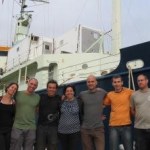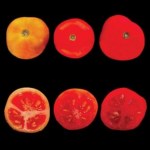basic research
Does your face reveal what’s in your heart? It might – even more than you know. Take, for instance, a common group of birth defects – forms of a disorder called DiGeorge syndrome. Around one in 4000 is born with this syndrome, which arises from a deletion of a short segment of chromosome 22. Among other problems, this deletion nearly always involves deformations in both the face and the heart.
Sculpture: Igor Mitoraj
The Institute’s Prof. Eldad Tzahor had already shown that face and heart go together: Very early on in the developing embryo, the progenitor cells that will…
Is anyone old enough to remember the ad in which two people walking down the street while snacking accidently bump into each other and discover peanut butter on a chocolate bar? Well, it turns out that when physics students run into each other on the street, the result is a quasicrystal with topological properties.
The students in question were members of two different labs in two different physics departments who were both out for a stroll on the same street in Tel Aviv – far from Rehovot and the Weizmann Institute. One was experimenting with a new kind of quasicrystalline optical system –…
The idea of “seeing the world through the eyes of a child” takes on new meaning when the observer is a computer. Institute scientists in the Lab for Vision and Robotics Research took their computer right back to babyhood and used it to ask how infants first learn to identify objects in their visual field.
How do you create an algorithm that imitates the earliest learning processes? What do you assume is already hard-wired into the newborn brain, as opposed to the new information it picks up by repeated observation? And finally, how do you get a computer to make that leap from a data-crunching…
You’ve heard of the carbon cycle, maybe even the nitrogen cycle. But have you given much thought lately to the sulfur cycle? New research in last week’s Science suggests that we should be paying a bit more attention to the way this element moves through the atmosphere, biosphere, oceans and land. Over the last 500 million years, sulfur seems to have played a fairly crucial role in keeping the oxygen levels in the atmosphere at a nice, breathable 20%.
It is microbes and weather that do the work. Microorganisms in the ocean take in sulfur in the form of dissolved sulfate – that is, in a sulfur…
We were just getting used to the idea of our digestive tract as an ecosystem. There are 10 times as many bacteria in our gut as there are cells in our bodies, and the ecological balance between the different types might affect everything from our tendency to gain weight to our general health and susceptibility to various diseases.
Now, a Weizmann Institute researcher has exposed a whole new layer of this ecosystem: the viruses – called phages – that infect our gut bacteria.
Dr. Rotem Sorek and his team identified hundreds of these phages in the human gut. They were able to find them thanks to…
Rose Eveleth talks to Assaf Vardi today on the Scientific American Expeditions blog:
http://blogs.scientificamerican.com/expeditions/2012/07/11/you-wanted-to-know-who-are-these-scientists-introducing-assaf-vard
One of our scientists, Dr. Assaf Vardi, is off on a month-long cruise. He is on the Knorr, a research vessel operated by the Woods Hole Oceanographic Institute, with a team from the Weizmann Institute and another four research teams on a route that will take them from the Azores to Iceland. On the way, they will be sampling the plankton; among other things they want to understand how the molecular processes that take place in these single-celled organisms affect everything from the ocean's food chain to the oxygen in the atmosphere. Rose Eveleth is posting from the ship daily on the…
Geneticist Dr. Maya Schuldiner has a lab full of the latest, shiniest robotic equipment. So why is she showing us pictures of socks? What she and her lab group mean to illustrate is that they have trained their research robots to find pairs – not of socks, alas, but of proteins.
The team and their robots entered an area of research in which protein matches had previously been painstakingly identified one at time – and discovered hundreds of new pairs in one fell swoop. Scientists are interested in these pairs because they are necessary for transporting signaling molecules – a group that…
Last month, Penn Medicine put out a press release heralding a "cancer treatment breakthrough 20 years in the making." In a small clinical trial, three patients with advanced chronic lymphocytic leukemia (CLL) were treated with genetically engineered versions of their own T cells. Just a few weeks after treatment the tumors had disappeared, and the patients remained in remission for a year before the study was published.
The release didn't, however, explain those "20 years in the making." In 1989, Prof. Zelig Eshhar of the Weizmann Institute's Immunology Department first published a paper…
Feel the need to eat chocolate when under pressure? You might be able to blame it on your genes, specifically a gene in the brain that responds to stress. This gene, when active, brings out your anxiety and as well as bringing about metabolic changes that tell your body to burn sugar, rather than fat. The same metabolic changes reduce insulin sensitivity in muscles, raising sugar levels in the blood, and causing the pancreas to churn out more insulin. According to the Institute scientists who revealed the gene's function, if the constant stress of daily life keeps this gene overworked, the…
It goes without saying that questions are the basis of scientific research. But all too often, especially in the PR department, we focus on the findings and forget about the process that led to those findings. So it was a refreshing change for us to put out an annual report on the theme of questions.
While the report takes as its premise the "big", even somewhat rhetorical questions, many of the featured scientists relate to the driving questions that keep them in the lab from morning to night.
In his message, Institute President Prof. Daniel Zajfman wrote:
Each new discovery leads to…
When you look over the assortment of sizes, shapes and colors of tomatoes displayed in the market, do you stop to consider the time and effort that went into developing them (more than ten years to create a new commercial cultivar)? But a variety of sweet, pink-skinned tomato that's popular in the Far East could speed-up the breeding of new cultivars in this region. In the search for the mutation that gives these tomatoes their pink hue, Weizmann scientists discovered a "master" gene that regulates the levels of hundreds of tomato metabolites. That gene, say the scientists, might be used as a…
Professor Daniel Zajfman, president of the Weizmann Institute of Science, is a physicist in the fields of atomic and molecular physics. He has a strong interest in the popularization of science
George Mallory, the man who almost made it to the top of Everest, is probably most famous for his terse reply when asked why he attempted to climb it: "Because it's there." Scientists often resemble mountain climbers: We want to understand nature because it's there. Why, in today's world, should we be devoting precious resources to finding out what happened in the Universe's first billionth of a…
For us at the Weizmann Institute of Science, joining the Scienceblogs site is something of an experiment: a blog for a whole institute. As we envision it, there will be several kinds of contributors. The Institute's leadership will add their thought-provoking views about science, both at the Institute and around the world. Other top scientists will be invited to contribute guest posts, as well. Finally, our team of Weizmann science writers will be blogging on some of the latest research that we write about in our magazines and press releases.
If you have never heard of the Weizmann…







